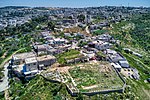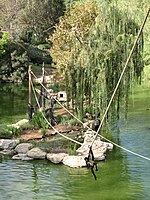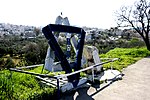Jerusalem–Malha railway station

Jerusalem–Malha railway station (Hebrew: תחנת הרכבת ירושלים – מלחה, Tahanat HaRakevet Yerushalayim–Malha; Arabic: محطة أورشليم – المالحة) was one of two Israel Railways termini in Jerusalem, the other being Jerusalem–Yitzhak Navon railway station. The station is located in the southern neighborhood of Malha, across from the Jerusalem Shopping Mall, Pais Arena and Teddy Stadium. As it is much less centrally located than Navon station, and the historic Jaffa–Jerusalem railway provides a much slower journey to the Tel Aviv area than the modern Tel Aviv–Jerusalem railway, ridership is very low. 115,118 passengers boarded or disembarked at the station in 2019, ahead of only the adjacent Biblical Zoo railway station and Dimona railway station. Service to the station has been suspended entirely since March 2020 due to poor usage combined with the economic impacts of the COVID-19 pandemic, and it is unclear if or when it will resume.
Excerpt from the Wikipedia article Jerusalem–Malha railway station (License: CC BY-SA 3.0, Authors, Images).Jerusalem–Malha railway station
Yitzhak Modai, Jerusalem Malha
Geographical coordinates (GPS) Address Nearby Places Show on map
Geographical coordinates (GPS)
| Latitude | Longitude |
|---|---|
| N 31.748083333333 ° | E 35.187533333333 ° |
Address
ת. רכבת מלחה
Yitzhak Modai
9695102 Jerusalem, Malha
Jerusalem District, Israel
Open on Google Maps











